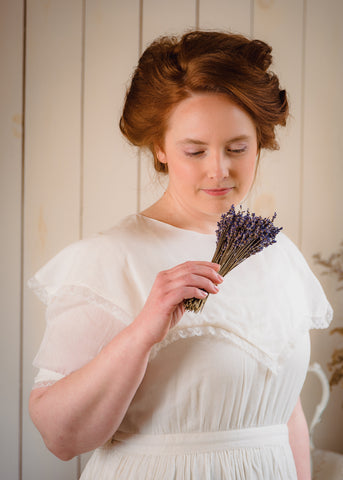Lavender is a popular plant in many gardens, and it’s no wonder why. The flowers produce a beautiful aroma, and the purple blooms are a delight to the eye. In addition to being a garden staple, lavender is also an excellent addition to your beauty routine! As you may have guessed, I’m a self-proclaimed “lavender lover” and I have been using this wonderful flower in my natural skin care products for over a decade. Let’s take a close look at what makes lavender so special!

About the Lavender Flower
Lavender enjoyed a heyday during the Victorian period when it was used to scent everything from perfumes, soaps, and floral waters to cosmetics and hair products. In contrast to the potent synthetic fragrances that are common on today’s store shelves, Victorians preferred subtle natural scents, and lavender became a popular choice. Thankfully, this lovely fragrance remains a classic favorite today!

Today, commercially-grown lavender (Lavandula officinalis) typically comes from France where the flower buds are harvested to be dried or are used to create lavender essential oil and hydrosols (or floral waters) by an extraction process called “steam distillation.” With this method, the fresh flowers are suspended over boiling water so that the steam draws the oils out of the plant. The steam is then rapidly cooled back into water and the essential oil separates from the water. The water left over during this process can then be used for hydrosols because it still contains some of the essential oil. (Read on to hear more about how you can use lavender hydrosol in your natural skin care routine!)
Lavender Health Benefits
This fragrant flower has many healing properties and has been an important ingredient throughout history for a variety of medicinal uses. Lavender also has many beauty benefits:
- Astringent: Gently balances oily skin
- Antiseptic and antibacterial: Wards off acne-fighting bacteria to keep skin clear
- Promotes healing: Helps boost cell regeneration
- Anti-inflammatory: Reduces redness, inflammation, and irritation
Lavender Uses
Thankfully, there are countless ways to enjoy the many unique properties of lavender. In fact, at Willow & Birch Apothecary, we love this plant so much that you can find lavender in many of our skin care and beauty products. It truly is a powerhouse for beauty benefits!
Lavender oil uses
Lavender essential oil is incredibly versatile and is a great way to make the most of the flower’s many beauty benefits. That’s why we use it in our moisturizing oils, bath salts, soap, face creams, and more! If you choose to use lavender oil in your own DIY beauty crafts, it’s important that you always dilute the essential oil in a carrier oil or in a mixed recipe before applying it to your skin. (Essential oils are extremely concentrated and applying them undiluted can harm the liver and kidneys.)
Lavender plant uses
- Dried lavender uses: The dried flower buds are especially nourishing for gentle face masks and scrubs. We also use ground lavender flowers for gentle exfoliation in our all-natural Lavender Breeze soap. For a fun beauty craft, try making a soothing clay facial mask by combining one tablespoon of ground dried lavender flowers with four tablespoons of kaolin clay. Then combine one to two tablespoons of the dry mixture with just enough water to form a paste. After washing with a gentle face soap, apply the mixture to your face, being careful to avoid your eyes. After 15 to 20 minutes, rinse with warm water and finish with your favorite moisturizing face cream!
- Fresh lavender uses: Make a lavender infusion by gently simmering the fresh flowers in a pot of water and use the aromatic floral water as a facial toner spray. You can also use the infused water in place of plain water when making the clay mask mentioned above!
Can you eat lavender?
Yes! Lavender makes a lovely tea with a lightly floral and herbaceous taste. If you grow lavender in your garden, you can use the mature fresh flowers to brew a delightful tea (I use about 1 teaspoon of flowers per cup of water.)

I’m so glad you’re enjoying the posts, Myra! And that the Lavender Breeze moisturizing oil is brightening your days and keeping your skin happy! <3
Anna, thanks for sharing your wisdom in your blog posts. I love using my Lavender Breeze Moisturizing Oil! Your wonderful product kept my skin moisturized throughout the winter, and also lifted my spirits! I will joyfully keep using it throughout the year as well as your lovely soaps. Gratefully, Myra
That’s so lovely, Ann! What a great idea to add lavender oil to your housecleaning products, too. I bet your home smells delightful! :-)
I love using lavender sachets to gently scent my handkerchiefs and bed linens. I keep diluted lavender oil in a roll-on in my purse as a perfume, but also to apply to mosquito bites as I find it stops the itch for a while. It’s also good for scenting homemade cleaners to leave your house smelling like Spring!